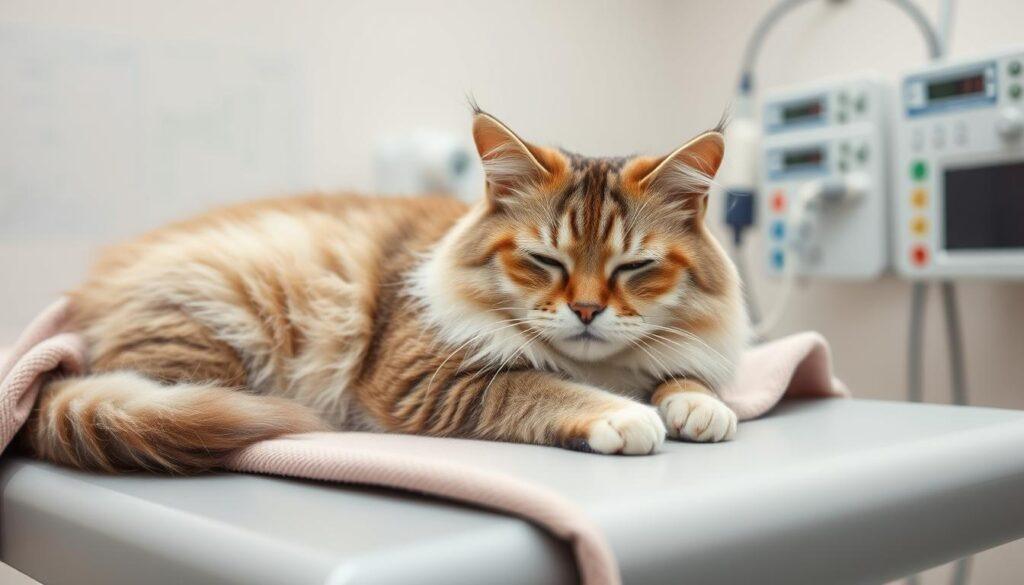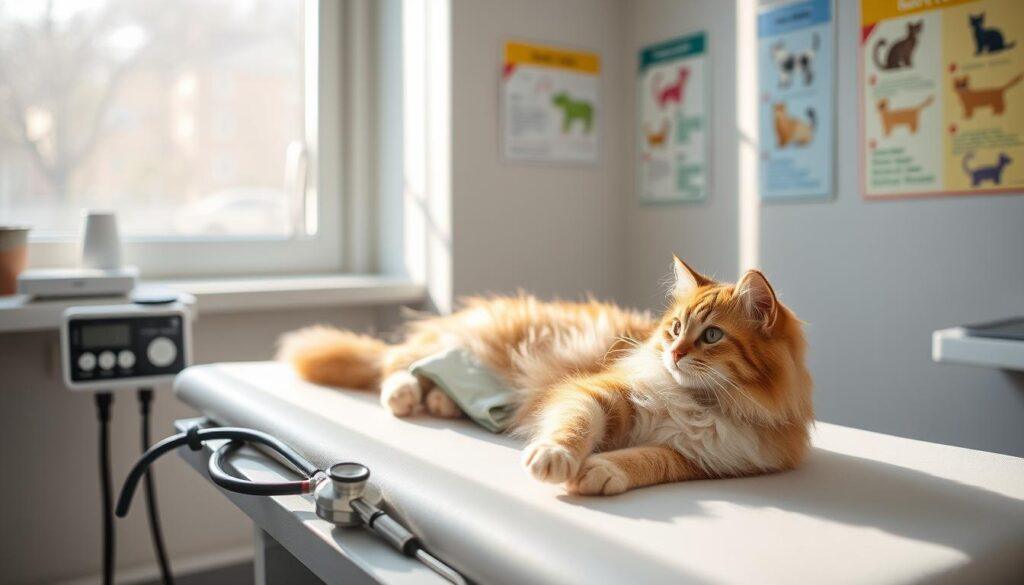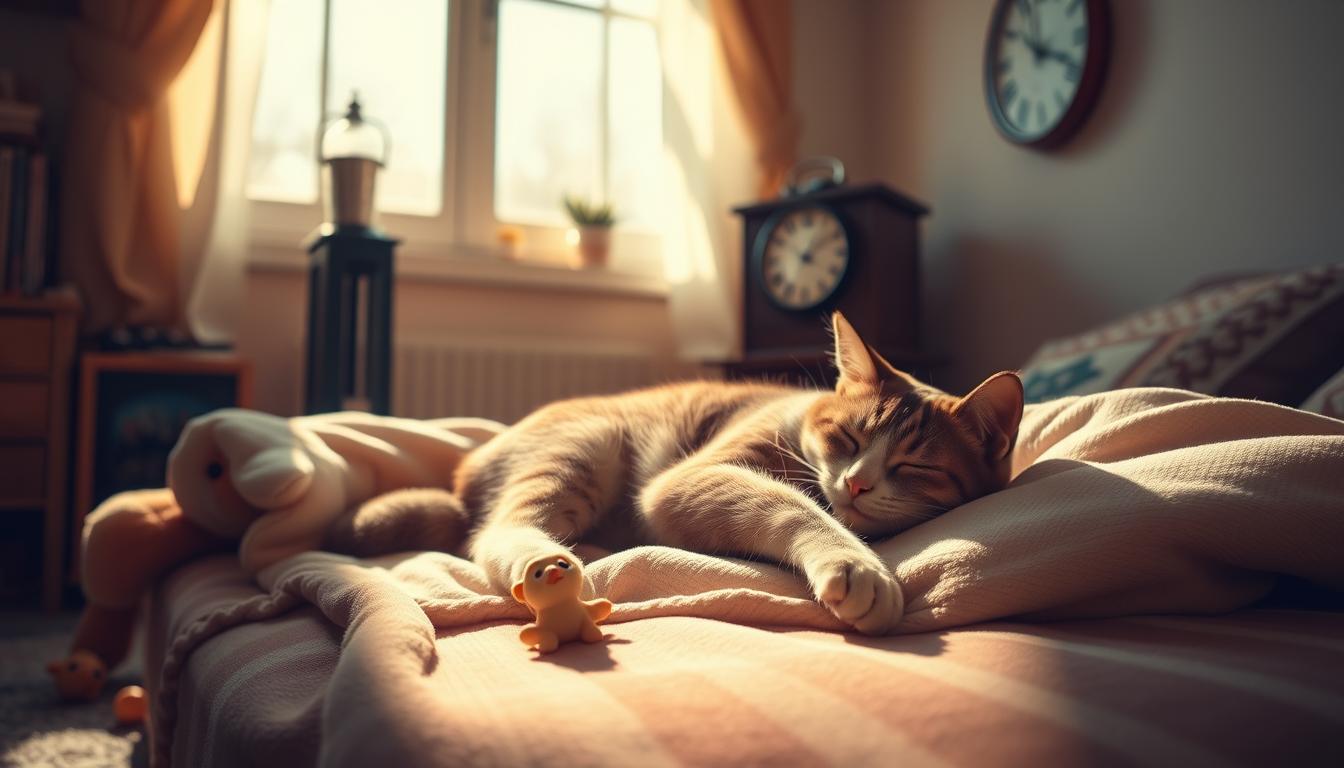Did you know that over 90% of cats need up to 24 hours to fully recover from general anesthesia1? Understanding how long does it take for cat sedation to wear off is crucial, as it varies based on the type of anesthesia, the cat’s age, and overall health. Feline anesthesia is essential for many vet procedures, ensuring cats remain still and pain-free during treatment.
Knowing about veterinary sedation protocols and recovery times is vital for cat owners. Most cats wake up in 5-10 minutes after the anesthesia stops. But, they might stay drowsy, disoriented, and move slowly for hours2.
The anesthesia type greatly affects sedation duration. Injectable anesthesia, like ketamine, makes cats unconscious for 30-60 minutes. They wake up slowly over 6 to 24 hours3. Gas anesthesia, like sevoflurane, causes quick loss and return of consciousness but is pricier than isoflurane3.
Watching your cat’s appetite is key during recovery. If they don’t eat for up to 48 hours after surgery, call your vet2. Also, make sure they have a quiet, comfy place to rest. Follow any pain or anxiety meds, and check the incision site for any issues2.
Key Takeaways
- Most cats require up to 24 hours to fully recover from general anesthesia
- The effects of anesthesia can last for several hours, causing drowsiness, lethargy, and disorientation
- The type of anesthesia used influences the duration of cat sedation and recovery time
- Monitoring appetite, providing a comfortable resting place, and following post-operative care instructions are crucial for a smooth recovery
- Common post-surgery side effects like coughing or shaking can occur due to anesthesia or pain relief medication
Understanding Cat Anesthesia and Sedation
Cat anesthesia and sedation are key for your cat’s safety and comfort during medical procedures. They help keep cats still, prevent pain, and let vets do needed treatments or surgeries.
Types of Anesthesia Used in Cats
Injectable anesthetics like ketamine and alfaxalone are common for cats. These drugs make cats unconscious during procedures. To keep them under, vets use isoflurane gas anesthesia through a tube in the cat’s trachea.
Common Procedures Requiring Anesthesia
Anesthesia is needed for many feline medical procedures, including:
- Feline dental procedures, such as teeth cleaning and extractions
- Spaying and neutering surgeries
- Cat wound care and suturing
- Fracture repairs and orthopedic surgeries
- Diagnostic imaging, such as X-rays and ultrasounds
Procedures needing anesthesia in cats include surgeries, dental work, wound repair, and X-rays4. Anesthesia costs can be a few hundred dollars to over $1,000. Some pet insurance may cover these costs5.
Differences Between Sedation and General Anesthesia
Sedation and general anesthesia are used to manage cats during medical procedures. But they differ in how they affect cats:
| Sedation | General Anesthesia |
|---|---|
| Milder form of anesthesia | Complete loss of consciousness |
| Cat remains conscious but relaxed | Cat is entirely unconscious |
| Some reflexes and pain response may be present | Absence of pain response and reflexes |
| Suitable for minor procedures or to calm anxious cats | Required for more invasive surgeries and lengthy procedures |
General anesthesia in cats means they lose consciousness and feel no pain. Sedation is milder, where cats are still awake but calm4.

Anesthesia is generally safe for cats, but there are risks. The chance of a cat dying from anesthesia is very low, at 0.1% compared to 0.05% for dogs4. About 0.11% of healthy cats die from anesthesia-related causes. Other studies show death rates from 0.24% and higher5. Cats with health issues like heart or kidney disease face higher risks during anesthesia4.
Anesthetic-related complications, including death, are quite rare, with 47 to 60% of complications occurring within three hours of anesthesia5.
Understanding cat anesthesia and sedation is key for your cat’s care during medical procedures. By working with your vet and following guidelines, you can reduce risks and help your cat recover well.
Preparing Your Cat for Anesthesia
Before your cat has surgery, it’s vital to prepare them well. This means a full check-up, blood tests, and making sure they don’t eat before the surgery. These steps help keep your cat safe and reduce risks.
Pre-Anesthetic Examination and Blood Work
Your vet will do a detailed check-up on your cat. They’ll look at your cat’s heart, lungs, and other important parts. This helps find any health issues that might affect how they react to anesthesia4.
Your vet might also suggest a blood test to check for organ problems. This test shows how your cat’s liver, kidneys, and blood cells are doing. It’s important for knowing how they’ll handle the anesthesia4.
Talking about your cat’s health history is also important. This helps your vet plan the anesthesia safely and effectively.
Fasting Requirements Before Anesthesia
To avoid a serious lung problem, your cat needs to fast before surgery. They should not eat for 12 hours before the surgery. This helps prevent vomiting during the anesthesia6.
| Fasting Period | Reason |
|---|---|
| 12 hours before surgery | Reduce risk of aspiration pneumonia |
| No food or treats | Empty stomach during anesthesia |
| Water allowed until a few hours before | Maintain hydration |
Your vet might also give your cat calming medicine before the surgery. This helps your cat feel less stressed and anxious.

By following these steps, you can make sure your cat is ready for their surgery. Remember, talking to your vet is crucial for a safe and successful surgery for your cat.
Monitoring Cat Anesthesia
Ensuring a cat’s safety during anesthesia is crucial. Veterinarians watch the cat’s vital signs closely. They use advanced tools to quickly spot and fix any problems.
Vital Signs Monitored During Anesthesia
A dedicated vet and technician watch the cat’s vital signs. They check heart rhythm, blood pressure, oxygen levels, breathing, and temperature. Tools like ECG for pets and pulse oximetry help keep the cat safe.
Most cats do well under anesthesia, but older or overweight cats face more risks7. About 0.11% of healthy cats might die from anesthesia problems5.
Duration of Anesthesia for Different Procedures
Anesthesia time varies by procedure. Dental cleanings need 2-3 hours, while neuter surgeries take about 10 minutes7. Vets choose anesthesia carefully for each cat’s needs.
Vital signs monitored during anesthesia and recovery include body temperature, respiration and pulse rates, blood pressure, blood oxygen, CO2 levels, ECG or EKG7.
Vets keep a close eye on the cat’s temperature, heart, and other vital signs. This careful monitoring helps keep the cat safe and ensures a smooth recovery.
Risks and Side Effects of Cat Anesthesia
Anesthesia is usually safe for cats, but there are risks and complications to know. These can be lessened with the right screening and monitoring.
Potential Complications During and After Anesthesia
Common issues include hypothermia, airway problems, and kidney injury. Cats can be hard to intubate, making the procedure tricky6. Aspiration is a risk because their airways are weak6.
Anesthesia can cause low body temperature, blood pressure, and oxygen levels6. Cats might have abnormal heart rhythms, rapid heart rate, slow breathing, and seizures6. About 10-15% of pets get constipated after anesthesia due to fasting and medication effects8.
After anesthesia, pets often feel tired, nauseous, and don’t want to eat. These symptoms usually last a few days8.
Mitigating Risks Through Pre-Anesthetic Screening
Screening before anesthesia, like blood work and an ECG, helps find health issues. This is crucial for older cats or those with health problems. Having a dedicated anesthesia nurse can make the surgery safer and reduce risks8.
Breeds More Susceptible to Anesthetic Complications
Some breeds, like Persians and Himalayans, face more risks due to their faces and airways. They need extra care and monitoring during anesthesia. Anesthesia risks increase for sick, older, overweight, or unhealthy cats6. Smaller cats also face higher risks6.
| Breed | Anesthetic Risks |
|---|---|
| Persian | Respiratory issues, hypothermia |
| Himalayan | Airway obstruction, hyperthermia |
| Exotic Shorthair | Breathing difficulties, prolonged recovery |
The risk of cat anesthesia death is about 0.24%. It’s important to talk about these risks and the vet’s experience. Monitoring during and after anesthesia can lower risks6. Cats may act strangely after anesthesia and need close watching6. If they don’t seem right in a few days, call the vet6.
While anesthesia carries some risks, the chances of serious problems are low. This is with the right equipment and experienced nurses8. For more information, see this article on cat behavior after anesthesia6.
How Long Does It Take for Cat Sedation to Wear Off
After your cat has a procedure with anesthesia, you might wonder how long it takes for them to feel normal again. The time it takes for cats to recover from anesthesia can vary. It can range from a few minutes to a few hours9.
Recovery Time Immediately After Anesthesia
When the anesthetic gas is turned off, cats usually wake up in 5-10 minutes. But, it can take several hours or even a day for them to fully recover. Most cats need up to 24 hours to get back to normal after general anesthesia1. Cats usually recover quickly, but it can take up to 24 hours for a full recovery9.
Factors Influencing Recovery Time
Several things can affect how long it takes for your cat to recover:
- Type and duration of anesthesia
- Cat’s age and overall health status
- Pain medications administered
- Procedure performed (e.g., neutering, dental cleaning)
For example, male cats need to wear an e-collar for at least 7 days after surgery. Females should wear it for at least 10 days1. The incision is closed with skin glue, which can be removed if it gets wet. Sutures are absorbable and usually dissolve in 6-12 months, so no suture removal is needed1.
Signs of a Cat Waking Up from Anesthesia
As your cat wakes up from anesthesia, you might see these signs:
| Recovery Stage | Signs |
|---|---|
| Early | Increased alertness, attempts to stand or walk |
| Mid | Ability to stand and walk, interest in food and water |
| Late | Return to normal behavior and activity levels |
It’s important to provide proper care for your cat after surgery. Keep them in a quiet, confined space away from other pets and children. Watch for signs of coughing, difficulty breathing, or vomiting after anesthesia9. If you see any signs of complications, like deep sleep or hard breathing, call the vet right away.
To avoid nausea after anesthesia, don’t feed your cat until the evening after the procedure. Give them a small portion of their regular meal, and return to normal diet the next morning9. Understanding the recovery stages and providing the right care can help your cat have a safe and comfortable recovery.
Conclusion
Knowing about cat anesthesia safety is key for pet owners. It helps ensure their cats get the best care. Cats might need anesthesia for many reasons, like check-ups, emergencies, or dental work10.
Vets use different types of anesthesia, like local, regional, or general, based on the procedure10. Before anesthesia, vets do thorough exams and tests. This makes sure the sedation plan fits the cat’s needs10.
During the procedure, trained techs and monitors watch the cat’s vital signs. This keeps the cat safe10. The time under anesthesia depends on the procedure and recovery plan. Anti-nausea meds usually last about 24 hours after surgery1011.
After anesthesia, it’s crucial to monitor the cat closely. Cats need 24 hours of rest and should move little for a week11.
Thanks to vet anesthesia advancements, cat safety has improved. But, it’s vital for owners to learn about it and work with their vet. Talking to your vet, following care instructions, and staying informed helps. This way, cats can safely get the care they need and live happy lives.
FAQ
How long does it typically take for a cat to recover from anesthesia?
What are the most common types of anesthesia used for cats?
What procedures typically require anesthesia in cats?
What is the difference between sedation and general anesthesia in cats?
What preparation is needed before a cat undergoes anesthesia?
What vital signs are monitored during cat anesthesia?
What are the potential risks and side effects of cat anesthesia?
How can the risks of cat anesthesia be minimized?
What should I expect during my cat’s recovery from anesthesia?
Source Links
- Post-Operation Instructions – SNAP San Diego – https://www.snap-sandiego.org/post-operation-instructions/
- Critter Creek Veterinary Hospital – https://www.crittercreekvet.com/site/blog/2023/02/28/cats-recovering-surgery
- Types of Anesthesia – All Feline Hospital located, 2300 S. 48th St. Suite 3 Lincoln, NE 68506 – https://www.allfelinehospital.com/types-of-anesthesia.pml
- Cat Anesthesia – What to Know If Your Cat Requires Anesthesia – https://www.ahofstatesville.com/services/cats/cat-anesthesia
- Anesthesia for Cats: What Is It, and Why Is It Used? – https://www.petmd.com/cat/procedure/anesthesia-for-cats
- Here’s What to Expect If Your Cat Needs Anesthesia or Sedation – https://www.dailypaws.com/cats-kittens/health-care/cat-anesthesia-and-sedation
- Cat Anesthesia: What Cat Owners Can Expect – https://www.hollyridgevetcare.com/services/cats/blog/cat-anesthesia-what-cat-owners-can-expect
- What Complications Can Happen at Home After Anesthesia? (Part 4) – https://www.drphilzeltzman.com/blog/what-complications-can-happen-at-home-after-anesthesia-part-4/
- Cat Anesthesia – Demystifying Cat Anesthesia – https://www.lochhavenvet.com/services/cat-wellness/cat-anesthesia
- Cats And Anesthesia: What You Need To Know – Cat Boarding Hotel Laguna, Mission Viejo, Anaheim, Santa Ana, CA | Cats Luv Us – https://www.catsluvus.com/cat-grooming/cats-and-anesthesia-what-you-need-to-know/
- Surgical After Care Instructions | Alicia Pet Care Center – https://mypetsdr.com/surgical-after-care-instructions/

